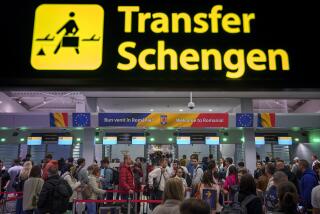Yugoslavia No More, Say Its Republics
- Share via
SKOPJE, Macedonia — Leaders of Serbia and Montenegro agreed Thursday to a landmark reform of their relationship, abandoning the name Yugoslavia and giving Montenegro more autonomy in order to avoid a messy independence fight.
The deal, sought by the European Union and brokered personally by EU foreign policy chief Javier Solana, creates two essentially independent states connected in a loose union from which either one can withdraw after three years. Under the agreement, the new entity will be called Serbia and Montenegro. The two republics currently make up the nation of Yugoslavia.
The goal, in part, was to avoid a referendum on Montenegro’s independence, for fear that it would set a regional precedent. The majority ethnic Albanian population in the province of Kosovo would like to secede from Serbia; and in the neighboring nation of Macedonia, many ethnic Albanians similarly would like to break away.
“This is an important day and a step toward the stability in the region and in Europe,” Solana said at a news conference in Belgrade, the Yugoslav and Serbian capital, where the agreement was signed by Yugoslav President Vojislav Kostunica and Montenegrin President Milo Djukanovic.
But the accord also signaled the formal end of the nation of Yugoslavia. Established in 1918, the country rose to become a progressive communist state, only to transmogrify into a nation identified with genocide, brutality and the most backward of policies. Before it began to disintegrate 12 years ago, though, the nation was admired for its multiethnic identity.
Yugoslavia means land of south Slavs, and it was home to all the Slavs in the Balkans except Bulgarians. For decades, it was a rare example of the peaceful coexistence of at least six ethnic groups--Serbs, Croats, Slovenes, Albanians, Hungarians and Macedonians. Under Marshal Josip Broz Tito, Yugoslavia was viewed as one of the most liberal of the communist states, balancing central economic controls with some intellectual freedoms.
However, almost from its inception, it had a history of dictatorship. Early on, it was run by a despotic Serbian king, Alexandar Karadjordjevic I, later by Tito and most recently by Serbian strongman Slobodan Milosevic, who is now standing trial on war crimes charges.
“People in Serbia regretted when Yugoslavia started crumbling 10 years ago,” said Bratislav Grubacic, a political analyst in Belgrade. “Now we have to admit there will be no more Yugoslavia after this, not as a name, not as a country,” he said.
Of the six republics that once made up Yugoslavia, Montenegro is the last to seek independence. In 1991, Croatia, Macedonia and Slovenia broke away. Then in 1992, Bosnia-Herzegovina sought independence. Bloody wars marked the separation of both Croatia and Bosnia. Montenegro’s independence drive began with the 1997 election of Djukanovic, who wanted to distance his tiny republic on the Adriatic coast from the autocratic rule of Milosevic, who was then Yugoslavia’s president.
Djukanovic won support from the West, which saw him as a counterweight to Milosevic. But after Milosevic’s fall last year, Djukanovic pressed on with his campaign, spurred by supporters in the southern portion of his republic.
In the north, where many pro-Belgrade Serbs live, Djukanovic encountered opposition, and the West began to see his press for independence as a problem. Not only did it create strife within Montenegro, but it also diverted Belgrade officials’ energy away from desperately needed financial and administrative reforms.
Most important, it risked setting a precedent for other small independence-minded areas in the Balkans, most notably Kosovo. By forestalling full independence for Montenegro, the issue of Kosovo independence is likely to be delayed as well.
Arguing that secession would also hurt Montenegro’s economy and slow down the process of integrating it into mainstream Europe, the EU has been pushing for a new Yugoslav Constitution that would preserve a joint Montenegro-Serbia state while granting the two republics greater self-governance.
Solana reassured the two republics that by signing the agreement, they would be putting themselves in a better position for EU membership, the long-term goal of all the Balkan countries. Montenegro and Serbia “should have no doubt” about the EU’s support, Solana said.
“This is not the end of anything, but a beginning of a new chapter that will bring you closer to the European Union.”
It is not yet clear whether Montenegrins will accept the deal. Djukanovic depends on a pro-independence party for his majority in parliament. If the party deserts him because of dissatisfaction with Thursday’s agreement, it could cause the fall of his government and trigger new elections.
Although the agreement keeps the two republics nominally linked, it recognizes that Montenegro and Serbia have become all but separate countries. “This is a legalization of the status quo,” said Stojan Cerovic, a columnist for the leading Belgrade news weekly Vreme. “Politically, Serbia and Montenegro are one country, but economically they are two countries.”
Although Montenegro has formally been part of the Federal Republic of Yugoslavia, it has refused to recognize the relationship for the past several years. Montenegro and Serbia have developed separate tax systems and separate customs regimes. Montenegro, with a population of about 650,000, uses the euro as its currency; Serbia, with about 10 million people, uses the Yugoslav dinar.
Under the agreement, Montenegro now will at least acknowledge a loose common government with Serbia. However, the two republics will continue to have separate economies, currencies and customs services, and each will be governed by its own president. They will be linked through a president of the new union, a unicameral parliament and a council of ministers.
The new union formally includes Kosovo, run by the United Nations since a 1999 North Atlantic Treaty Organization bombing campaign against Yugoslavia in response to Milosevic’s brutal crackdown on the province’s ethnic Albanians.
However, analysts believe that the union structure will be weak.
The name change will not take effect until the deal is approved by the parliaments of both republics as well as the Yugoslav legislature.
More to Read
Sign up for Essential California
The most important California stories and recommendations in your inbox every morning.
You may occasionally receive promotional content from the Los Angeles Times.













